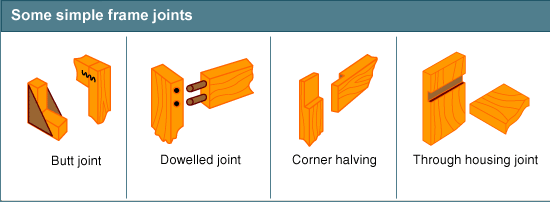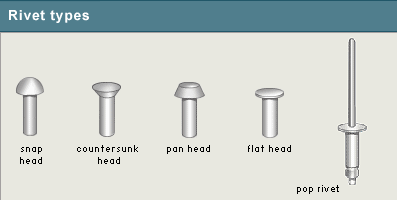Joints in wood can be with screws, nails, glues an knock down components, or with frame joints.
Joints in metal can be made with brazing, soldering and welding or rivets.
Joints in plastics can be made with plastic adhesive, rivets, bolts or machine screws.
Permanent joints are intended to stay put. They may make use of adhesives, nails, rivets, or one of the heat processes of brazing, soldering and welding Assembly jigs are often used to hold components in place while they are being joined. For example, the parts of a steel roof frame can be put into the jig and then welded together.
Temporary fixings usually involve components with a screw head, such as screws, nuts and bolts, or one of the many knock down fixings on the market.
Wood fittings
Screws come with different types of head. They can be flat or round-headed, and be fitted with a slot (for traditional screwdrivers), crosses (for Phillips or Posidrive screwdrivers) or square holes (for square drivers). If the screw head is to lie flush with the surface of the wood, the hole must be enlarged or countersunk.
Self-tapping screws are made from very hard steel. They have a thread which goes all the way up to the head, and cut an internal thread as they are screwed in. They can be used in metal and plastic as well as wood. Machine screws are used for joining metal and plastic components.

Nails come in different shapes and sizes. Nails are much cheaper than screws and quick to put in. You do not need to drill holes in the wood first, except sometimes when using hard wood or to prevent the wood splitting.
Glues can be used, however can be hard to use

Much furniture is sold in flat packs. This makes it easy to transport and store. The customer then has to assemble it at home. Usually knock-down (KD) fittings are used. Most KD fittings consist of corner blocks or bloc-joint fittings. Usually these are made from a plastic such as nylon.
A butt joint can also be strengthened by gluing dowel into both parts - making a dowelled joint. Dowelled joints are good for joining man-made boards (modified timbers) which might split easily if screwed or nailed.
Corner halving joints are stronger than butt joints, as there is more contact for gluing, and the shoulder gives extra mechanical strength. Through housing joints are used for shelves.

Mortise and tenon joints, though more difficult to cut, are very strong, because of the shoulders
Dovetail joints are very strong and look good - but are complex and difficult to cut. They are often used in high-quality furniture.

Comb or box joints are easier to make - especially by machine - and offer good contact for gluing. They are often used in wooden boxes.
Edging - when pieces of wood are joined along their edges, the joint may need to be supported in some way to reinforce or make it look neater. Sometimes a strip of wood is glued or pinned over the joint, called lipping. Sometimes - eg with floorboards or timber cladding - a thin strip projecting from one edge slots into a slot in the other edge. This is called a tongue and groove joint.
Joining metals
Brazing is a way of bonding materials (usually metals) by melting a filler metal or alloy between the components you want to join. The filler metals used in brazing usually have melting points between 450°C and 1000°C, but must have a lower melting point than the material being joined. Brazing forms very strong, permanent joints.
Welding is different from soldering in that the two pieces of metal are themselves melted along the joints, fusing together as they cool. In oxy-acetylene welding a very hot flame is used. In electric arc welding a spark is used to heat the metal. In both processes a filler rod may used as well to get a really strong joint.
Machine screws are special screws for joining metal components, which unlike wood screws do not have a tapering core (like bolts, but smaller). Machine screws have to go into a pre-drilled hole in the component which is the right size and which has the correct internal thread.

Rivets are components used for joining metal (and sometimes plastics and plywood). A hole is drilled through both pieces of work, the rivet placed through it, and its end beaten into a dome. A tool called a rivet set or rivet snap is used to to finish the joint off neatly. Some rivets are countersunk.
With most rivets you need to get at both sides of the work to make the joint. Pop rivets enable you to complete the joint while only having access to one side of the work. They are usually used for joining thin sheets together.
Joining plastics
Plastic products are often moulded so they just snap together. If you have to make permanent joint, a specialist adhesive is often the best choice.
Plastic adhesives
Plastic weld is a multi-purpose plastic adhesive that joins most types of plastics (do not use it in on foamed plastics).
Tensol 12 is good for acrylic. It is quick and easy to use. But if spilt it marks the work. It is not very strong.
Tensol 70 is much stronger. It is acrylic based. It comes in two parts. It is not easy to use, as it takes 1.5 hours to harden and contracts.
Rivets, nuts, bolts and machine screws can also be used for joining plastics.
Source: https://www.thestudentroom.co.uk/attachment.php?attachmentid=100699&d=1304540580
Web site to visit: https://www.thestudentroom.co.uk/
Author of the text: indicated on the source document of the above text
If you are the author of the text above and you not agree to share your knowledge for teaching, research, scholarship (for fair use as indicated in the United States copyrigh low) please send us an e-mail and we will remove your text quickly. Fair use is a limitation and exception to the exclusive right granted by copyright law to the author of a creative work. In United States copyright law, fair use is a doctrine that permits limited use of copyrighted material without acquiring permission from the rights holders. Examples of fair use include commentary, search engines, criticism, news reporting, research, teaching, library archiving and scholarship. It provides for the legal, unlicensed citation or incorporation of copyrighted material in another author's work under a four-factor balancing test. (source: http://en.wikipedia.org/wiki/Fair_use)
The information of medicine and health contained in the site are of a general nature and purpose which is purely informative and for this reason may not replace in any case, the council of a doctor or a qualified entity legally to the profession.
The texts are the property of their respective authors and we thank them for giving us the opportunity to share for free to students, teachers and users of the Web their texts will used only for illustrative educational and scientific purposes only.
All the information in our site are given for nonprofit educational purposes